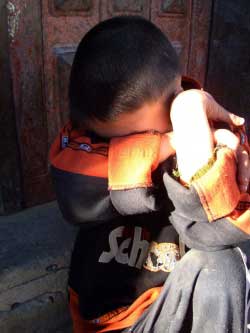Gaza: Frustration, Suffocation And Crisis
By Eva Bartlett
02 March, 2010
Ingaza.wordpress.com
Nidal Abu Leila, 10, lost his ability to speak, think and walk, a result of trauma from the sustained Israeli bombing of Gaza last year. The Gaza Community Health Centre found that 91.4 per cent of children in Gaza displayed symptoms of moderate to very severe Post-Traumatic Stress Disorder.

GAZA—The Gaza Strip was already spiraling under years of siege long before the F-16 fighter planes, Apache helicopters, tanks, warships, unmanned aerial vehicles and armed soldiers waged a 23-day war on the Strip in winter 2008-2009.
The agricultural sector, which used to provide 50 per cent of Gaza’s food needs, had been steadily failing as a result of the siege and Israel’s policy of aggression in border regions. The Israeli-led, internationally-complicit siege bans all but roughly 40 items from entering Gaza.
In 2008 the Agricultural Development Association (PARC) reported a desperate need for nylon used in hothouses, irrigation piping, fertilizers, seeds, seedlings and pesticides. In March 2009, the United Nations’ Office for Coordination of Humanitarian Affairs (OCHA) reiterated the call, adding animal feed, livestock, olive and fruit tree saplings, saying the need was “urgent” and “very urgent.”
The Israeli war on Gaza destroyed between 35 and 60 per cent of agricultural sector, tearing up irrigation networks, destroying hundreds of wells, water pumps, and cisterns, farm buildings and machinery, and killing over 35,000 cattle and sheep, and over 1 million chickens and birds.
The most fertile areas of the impossibly small Strip lie in Gaza’s border regions—inhabited but largely undeveloped. Of the 175,000 dunams of cultivable land, 60-75,000 dunams have been destroyed by Israeli invasions and operations.
The Israeli-imposed “buffer zone” in theory renders 300 metres flanking the borders off-limits. Israeli authorities say anyone within that zone risks being shot by Israeli soldiers. In reality, Israeli soldiers shoot and shell up to two kilometres from the border, rendering more than one-third of Gaza’s farmland inaccessible.
Since the end of Israel’s war on Gaza on January 18, 2009, at least 13 Palestinian civilians have been killed and 39 injured in and outside of the “buffer zone” by Israeli soldiers’ shooting and shelling. Children are among the casualites.
Despite the danger, farmers continue planting and farming. The inability to regularly access their land has meant many farmers sow low-maintenance crops instead of the diverse array of vegetables, grains and fruits that once flourished in Gaza.
Before Israeli bulldozers razed the fruit and olive trees that abounded along Gaza’s borders, bee-keepers were able to produce high-quality honey two or three times per year. Many bees have died out from Israeli bulldozing and during the last Israeli war on Gaza. In the absence of trees, most of the remaining bee-keepers substitute sugar-water for flowers.
The Palestinian fishing industry, employing more than 3,500, has been devastated by Israeli attacks on fishing boats, confiscation of boats and equipment, and the abduction of Palestinian fishermen.
Under the 1993 Oslo Accords, Palestinian fishermen have the right to fish 20 nautical miles off Gaza’s coast. Israeli authorities have steadily down-sized fishing zone limits. In 2008, fishermen were warned not to go beyond six miles. Currently, Israeli gunboats prevent fishermen from passing three miles.
Fishermen report being attacked by machine gun shooting, water cannons and shelling from Israeli gunboats within three miles of the coast. Israeli naval soldiers routinely force Palestinian fishermen in large vessels, or small hassakas just 2-300 metres off the coast, to motor or row out beyond the Israeli-imposed limit, whereupon the fishermen are abducted and arrested.
Abducted fishermen report being forced at gunpoint to strip, jump into the water (frigid in winter) and swim tens of metres to a retreating Israeli gunboat where they are hauled aboard, blindfolded and handcuffed, sometimes beaten, interrogated and taken to Israeli detention for one or more days.
The interrogations often include coercion, via threat and financial enticement, to work with Israeli intelligence.
Their fishing boats are frequently confiscated for months, often returned damaged or with equipment and parts missing.
Fishermen say the bounty of fish lie beyond the six mile limit. Reduced to fishing along the coast, the sparse catch comes from waters contaminated by 80 million litres of raw or partially-treated sewage pumped daily into the sea for want of proper sewage maintenance plants.
While Egypt is building a steel wall intended to cut off the hundreds of tunnels running between Gaza and Egypt, tunnelers say they will dig deeper. Palestinians in Gaza say they need the tunnels: they are a lifeline, bringing the imaginable—chocolates, cigarettes, medicines, appliances—to the unimaginable—livestock, cars, people.
Unemployment remains rife at near 50 per cent, with food aid dependence and poverty at over 80 per cent. Educated youths with university degrees languish without work, or take jobs driving taxis for a paltry salary. Students craving higher education, and with scholarships abroad, remain imprisoned by Gaza’s siege-closed borders, losing study and scholarship opportunities.
One year later, virtually nothing has changed, except the frustration, suffocation, and manufactured crises have worsened.
A complete schedule of Israeli Apartheid Week with speaker biographies is available on the website.


